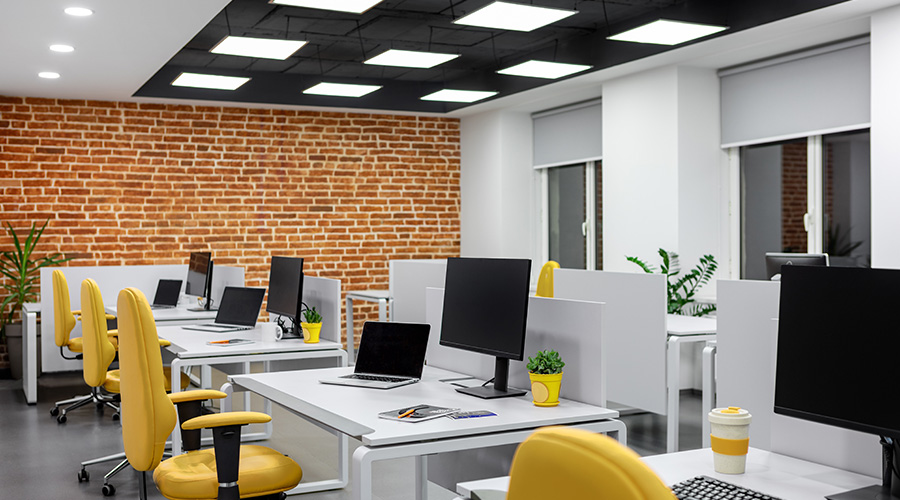Measures raise acoustics issues for schools, health care facilities
If you walked into a noisy classroom, you might be hard pressed to hear anything amiss.
If you walked into a quiet medical office, you probably wouldn’t think you’re hearing anything out of the ordinary there either.
Sound and silence are important environmental considerations in educational or medical settings. According to new industry standards and federal rules, what you’re hearing – or not hearing – can cause big problems. Some classrooms are so noisy that learning is affected. On the other hand, some medical offices are so quiet that the confidentiality of personal information can be compromised.
New privacy rules associated with the Health Insurance Portability and Accountability Act of 1996 (HIPAA) protect individually identifiable, orally transmitted health information. Health care providers – from doctors’ offices to grocery store pharmacies — are required to implement “appropriate” policies and procedures that “reasonably minimize” the amount of protected health information that can be intentionally or accidentally overheard. The rules, however, do not define exactly what “reasonable” is.
Meanwhile, the new Acoustical Performance Criteria, Design Requirements, and Guidelines for Schools, recently approved by the American National Standards Institute (ANSI), establishes new criteria for acoustical performance within classrooms.
The purpose of these voluntary acoustic guidelines is to improve speech intelligibility in learning spaces so children will be able to hear more clearly. The guidelines are designed specifically to improve educational settings for students with hearing and learning disorders, English-as-a-second-language students, and elementary-aged children, says Kring Herbert, a principal with Ostergaard Acoustical Associates, an acoustical consulting firm.
“Noise in the classroom inhibits learning,” he says. “When sound is bouncing around, it’s hard to understand the speaker.”
The rules call for the removal of “selective barriers,” says Kenric Van Wyk, president of Acoustics by Design, another acoustics consultant. “Selective barriers mean classrooms are unavailable because of the noise.”
Van Wyk says a noisy classroom presents the same kinds of barriers to a hearing-impaired student that a second-floor classroom without a ramp or elevator presents to a student in a wheelchair.
Measuring Sound
According to the ANSI standard, the background noise level of an unoccupied classroom should drop from the longstanding recommendation of about 42 to 37 decibels (dBA) to 35 dBA. (The “dBA” means sound is measured using an A weighting filter.) That means the sound inside an empty classroom should be no louder than a soft whisper, Van Wyk says.
Normal speech is 60 dBA. Alone, most air vents are 50 to 55 dBA.
“That’s very loud,” he says.
Ken Roy, head of the U.S. delegation to the International Organization for Standardization (ISO) for building acoustics and author of the ANSI guidelines’ first draft, says there are two paths school districts can pursue to meet the standards. The first is to follow the performance standard, which outlines specific goals for classroom acoustics, but offers no strategies for reaching those goals.
Using this method, school districts must hire an acoustical consultant to measure classroom noise levels, identify the causes of those sounds and develop solutions. On-site evaluations usually take a few days, Herbert says.
The second path, the prescriptive method, offers specific recommendations for reaching the performance goals. Using this method, school districts select acoustical solutions based on assumptions and observations rather than exact measurements. Schools using this method may end up overcompensating for problems and overspending on acoustical materials.
New buildings can probably meet the standards with minimum modification. Meeting the standards in older buildings will be more difficult and virtually impossible in portable buildings, says Roy, who also is a principal research scientist with Armstrong World Industries, a manufacturer of ceiling systems.
System Noise
Regardless of the building’s age, mechanical systems are often the top cause of extraneous classroom racket. Solutions vary depending on the exact cause of the din and the age of the system. For example, if the HVAC unit generates a high-frequency whistle, then installing larger air diffusers might solve the problem. If the sound is a low-frequency hum, silencers or mufflers might do the trick, Roy says.
Older systems can be replaced with quieter heat pumps or relocated above the tile ceiling, Van Wyk says.
In portable classrooms with self-contained air-conditioning window units, the solutions are a little more involved — and expensive. Noise reduction may call for replacement of old, clanky window units with newer models. Quieter window units can cost up to $4,000 compared to $1,500 for traditional units, Van Wyk says.
Outdoor distractions such as transportation noises or even playground clamor also can raise the volume inside the classroom. One solution is to replace windows with double-paned glass or add a second layer of glass on top of the existing window to create an air gap, Roy says.
Window assembly acoustical performance is as important as the glass, Herbert says, because it blocks sound.
Sounds generated by the occupants themselves also contribute to the amount of noise bouncing around the classroom. In a 30-by-30-foot room with a 9-foot ceiling, noise can be reduced 20 percent — 5 to 6 dB — with high-performance acoustical ceiling tile. Adding acoustical wall panels can reduce noise by another 5 to 6 dB.
While cost is difficult to estimate, Roy pointed out that it is more cost effective in the long run to work with a consultant to measure the problems and identify solutions.
Sounds of Silence
Exactly how new speech privacy regulations associated with HIPAA affect medical facilities is open for debate.
Laurence Hughes, a member of the American Hospital Association’s regulatory council, says the new rules are directed more toward personnel behavior than facility acoustics.
“The new rules focus on behavioral changes,” he says. “We don’t think they require architectural changes. For example, if you’re in an open area, talk in a low voice.”
Acoustical experts disagree.
“‘Privacy’ is a relative word,” says Fred Folsom, executive vice president of client education for Dynasound Sound Masking Solutions.
Privacy is defined as “confidential” where no one can overhear; “normal” where the conversation is audible but intelligible; and “poor” where everyone can hear every word, he says.
“HIPAA calls for reasonable safeguards,” says Niklas Moeller, vice president of KR Moeller Associates Ltd., a sound masking system manufacturer. “Speech can be audible, if it’s not intelligible. Each organization must assess its compliance. To do nothing is unacceptable.”
The “ABC” formula for acoustical design will work well in most health care environments, says Anita Snader, marketing manager for Armstrong’s commercial ceiling system for education and environmental segments.
ABC stands for absorb, block and cover. Absorption reduces the amount of noise that can escape one room and enter another. To improve sound absorption, ceilings should be at least 9 feet tall and should be made from acoustical tile with an AC 200 rating.
Strategic space design and furniture placement can significantly block sound paths from traveling to unintended listeners. To effectively achieve normal privacy, room dividers should be at least five feet tall and have an STC rating of 24. In addition, four-sided, staggered cubicles block more sound than three-sided cubicles.
Many of the sound-absorbing and blocking techniques used in schools can be applied to health care. But when it comes to covering sound, there is a major difference between school and health care settings.
“The reason there’s a problem with health care spaces in the first place is because the background sound is too low,” Moeller says. “You have to increase sound.”
Covering Up Sounds
Cover or masking is particularly important in open spaces, such as reception areas and open counters common in pharmacies, where any sort of privacy is virtually nil. Sounds from HVAC systems and music help to cover conversations but aren’t dependable. HVAC units cycle off and on. Music doesn’t maintain a constant sound level.
Sound masking set at 40 dB and combined with music can bring the sound level to 52 dB, Roy says. As a result, conversations become less intelligible at even a few feet.
Sound-masking systems typically consist of electronically generated sounds broadcast via speakers mounted above a ceiling. Systems cost about $1 per square foot.
Computer modeling shows that sound masking can increase speech privacy dramatically in “totally open” pharmacy counter areas, Folsom says. “The level of speech privacy increased 300 percent from a person talking behind the counter, to a person listening from a distance of 12 feet away from the talker on the other side of the counter.
“At that point you have to be actively eavesdropping,” Folsom says.
Lynn Proctor Windle is a freelance writer who has written extensively about real estate.
Related Topics:











